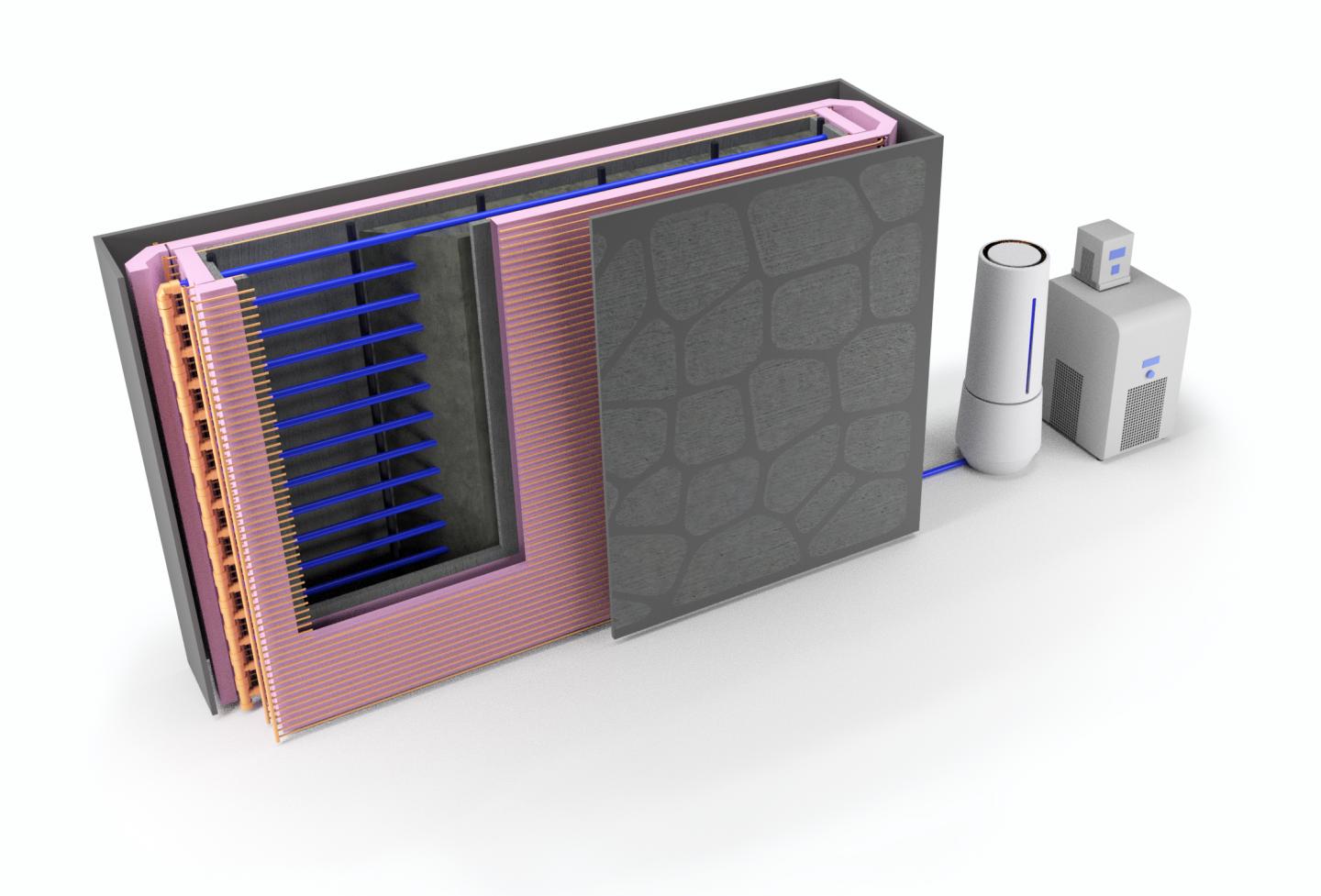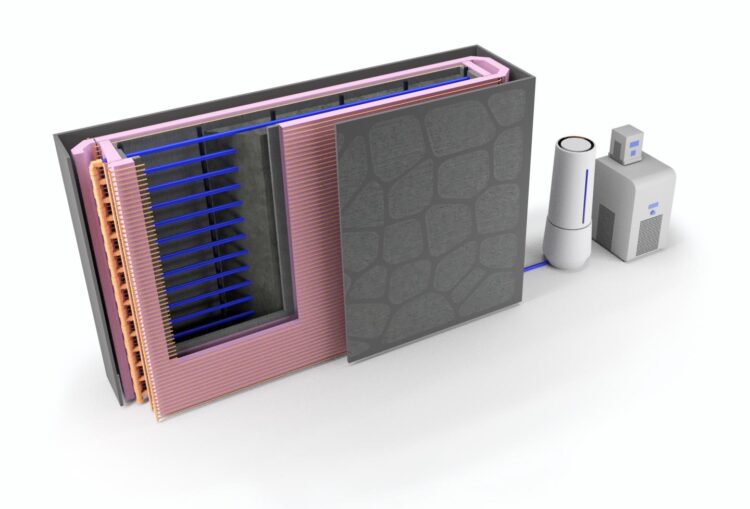
Credit: ORNL, U.S. Dept. of Energy
Buildings – Cool smart walls
Oak Ridge National Laboratory researchers used additive manufacturing to build a first-of-its kind smart wall called EMPOWER. The wall, designed for a building’s interior, also functions as a cooling system to optimize energy use and lower overall cost.
The prototype wall was manufactured with a cable-driven, field deployable concrete additive manufacturing system and embedded with a thermal storage and active insulation system. A chiller connected to the wall pumps cool water through pipes. That coolness is stored in the interior and then transferred throughout the room as needed.
“With the ability to function not just as a support wall but also as the room’s cooling system, the wall can lower utility bills and maintain occupant comfort while reducing energy use,” said ORNL’s Melissa Lapsa, who led the project sponsored by the Federal Energy Management Program.
Researchers will build two additional walls for installation in office buildings and monitor their performance and functionality for a year.
Media Contact: Jennifer Burke, 865.414.6835, [email protected]
Video: https:/
Caption: ORNL researchers 3D printed a concrete wall embedded with a thermal storage and active insulation system that allows the wall to function as a cooling system. Credit: ORNL, U.S. Dept. of Energy
Materials – Magnetism does the twist
Scientists discovered a strategy for layering dissimilar crystals with atomic precision to control the size of resulting magnetic quasi-particles called skyrmions. This approach could advance high-density data storage and quantum magnets for quantum information science.
In typical ferromagnets, magnetic spins align up or down. Yet in skyrmions, they twist and swirl, forming unique shapes like petite porcupines or tiny tornadoes.
The tiny intertwined magnetic structures could innovate high-density data storage, for which size does matter and must be small. The Oak Ridge National Laboratory-led project produced skyrmions as small as 10 nanometers – 10,000 times thinner than a human hair.
“The way we design and synthesize the superlattice creates the atomic-scale magnetic interactions responsible for twisting the spins,” said physicist Elizabeth Skoropata, who co-led the study with John Nichols, both formerly of ORNL.
ORNL’s Ho Nyung Lee added, “Our finding demonstrates how to precisely engineer interfaces in oxide quantum heterostructures to create nanometer-sized skyrmions.”
Media Contact: Dawn Levy, 865.202.9465, [email protected]
Image: https:/
Caption: The layering of crystals into a superlattice yields a nanoscale magnetic structure of twisting, swirling spin orientations, shown from red to blue, that deflect electrons, shown as white dots. Credit: Adam Malin/ORNL, U.S. Dept. of Energy
Nuclear – Fuel cost savings
A developing method to gauge the occurrence of a nuclear reactor anomaly has the potential to save millions of dollars.
Oak Ridge National Laboratory is looking to answer a longtime question: What’s the risk associated with fuel fragmentation, relocation and dispersal? That happens when fuel pellets in a reactor core degrade under accident conditions and extensive operation. If the cladding protecting the fuel bursts, fuel could be dispersed into the reactor core, potentially increasing the accident consequences.
Nathan Capps and colleagues are using the BISON fuel performance code and ORNL’s hot cell-based severe accident test station – one of two worldwide – to identify and mitigate risk. That could pave the way for reactors to safely operate on longer cycles with less waste. The environmental impact and cost savings would be significant, he said – millions annually.
“This approach completely revolutionizes the nuclear industry, making nuclear energy safe and economically viable carbon-free energy sources,” Capps said.
Media Contact: Kristi Nelson Bumpus, 865.253.1381, [email protected]
Image: https:/
Caption: This graphic shows the evolution of a rodlet during a high burnup loss-of-coolant accident test at the ORNL severe accident test station facility. As the rod’s cladding balloons and bursts, fuel fragments can be dispersed. Credit: Jaimee Janiga/ORNL, U.S. Dept. of Energy
Image: https:/
Caption: Fuel pellets sometimes degrade to a sandlike consistency and can disperse into the reactor core if a rod’s cladding bursts. ORNL researchers are studying how often this happens and what impact it has, in order to let reactors operate as long as possible without increasing risk. Credit: Jaimee Janiga/ORNL, U.S. Dept. of Energy
Nanomaterials – Short polymers, big impact
Oak Ridge National Laboratory scientists have discovered a cost-effective way to significantly improve the mechanical performance of common polymer nanocomposite materials. The discovery could lead to stronger, more durable materials for applications ranging from biomedical devices to automobile tires.
Glassy polymer nanocomposites, or PNCs, are sought-after materials with hard filler nanoparticles dispersed throughout their soft polymer matrices. While studying why PNCs demonstrate certain advantageous properties, researchers tried mixing in short and long chains of the same polymer.
“We found that by adding a small amount of the short polymer chains, the resulting mechanical properties were improved by 20%,” ORNL’s Vera Bocharova said. “This is good for practical applications.”
Experimental data and computer simulations revealed that changes to polymer-nanoparticle interactions, polymer stretching, and density at nanoparticles’ interfaces were responsible for the enhanced properties. The study results can be universally applied to PNCs and may help researchers design future materials with desired qualities.
Media Contact: Abby Bower, 865.323.9943, [email protected]
Image: https:/
Caption: Researchers used computer simulations to produce images of polymer nanocomposite materials. Nanoparticles are shown in pink and long polymer chains in cyan. Credit: Jan-Michael Y. Carrillo/ORNL, U.S. Dept. of Energy
Image: https:/
Caption: Simulations depict polymer nanocomposite, or PNC, materials. Mixing optimal amounts of short and long polymer chains, purple and cyan, improved PNC mechanical properties. Credit: Jan-Michael Y. Carrillo/ORNL, U.S. Dept. of Energy
###
Media Contact
Sara Shoemaker
[email protected]
Original Source
https:/
Related Journal Article
http://dx.





